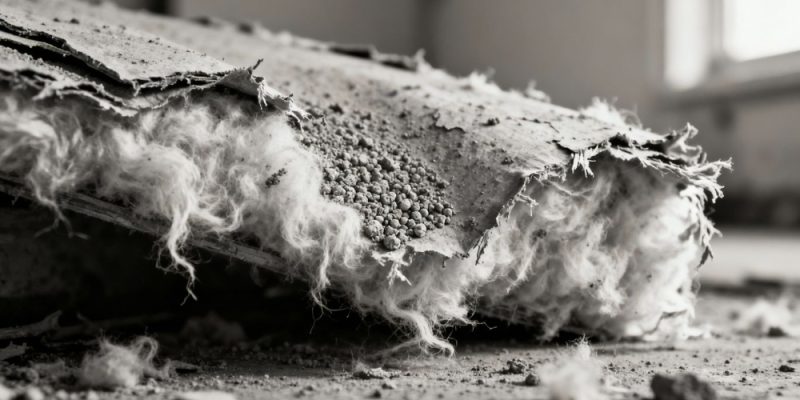
Historical Use of Asbestos in Construction
Asbestos was a popular building material for decades, especially in homes built before the 1980s. Its properties, like heat resistance and durability, made it seem like a good choice for construction. Many different products used asbestos, from insulation to flooring tiles. It’s estimated that most homes built before 1990 could contain asbestos materials. Because it’s not something you can see or smell, its presence often goes unnoticed. Identifying these materials is the first step in managing potential risks. You can find more information about its historical use on the EPA website.
Common Locations of Asbestos in Residences
In a typical home, asbestos can be found in several places. It was often mixed into building materials to make them stronger or more resistant to heat and fire. Some common spots include:
- Insulation: Around pipes, boilers, and in attic or wall insulation.
- Flooring: Vinyl floor tiles and the adhesive used to glue them down.
- Ceilings: Textured paints and ceiling tiles.
- Walls: Some older plaster and joint compounds.
- Roofing and Siding: Asbestos cement shingles and siding.
Knowing these common areas can help residents be more aware of potential hazards within their homes.
Health Implications of Asbestos Exposure
Diseases Linked to Asbestos Inhalation
When asbestos fibers are disturbed, they can become airborne and inhaled. These tiny fibers can lodge deep within the lungs and other tissues. Over time, this can lead to serious health problems. The most well-known disease associated with asbestos is mesothelioma, a rare and aggressive cancer that affects the lining of the lungs, abdomen, or heart. Other asbestos-related conditions include lung cancer, asbestosis (a chronic lung disease causing scarring and shortness of breath), and pleural thickening. It’s important to remember that these conditions often take many years to develop after exposure. For those who served on ships, the risk of exposure was particularly high due to its widespread use in various compartments, including boiler rooms and engine spaces.
Latency Periods and Risk Factors
One of the most challenging aspects of asbestos-related diseases is their long latency period. This means that symptoms may not appear for 10, 20, or even 50 years after the initial exposure. This extended timeframe can make it difficult to connect past exposures to current health issues. Several factors can influence an individual’s risk:
- Duration and intensity of exposure: The longer and more concentrated the exposure, the higher the risk.
- Type of asbestos fiber: Different types of asbestos fibers may carry varying levels of risk.
- Individual susceptibility: Genetic factors and overall health can play a role.
- Smoking: Smoking significantly increases the risk of developing lung cancer when combined with asbestos exposure. It’s a dangerous synergy that amplifies the danger considerably.
Identifying Potential Asbestos Hazards
Spotting asbestos in your Navy housing might not always be straightforward, as it was often mixed into building materials. However, there are certain indicators and locations where it’s more commonly found. Recognizing these potential problem areas is the first step toward ensuring your family’s safety.
Visual Clues and Building Materials
Asbestos fibers are microscopic, so you can’t see them with the naked eye. The danger comes when these materials become damaged or disturbed, releasing fibers into the air. Some common building materials that may contain asbestos include:
- Insulation: Particularly older types used around pipes, boilers, and attics. These might look like a fibrous, greyish material.
- Textured paints and coatings: Often found on ceilings and walls, sometimes referred to as ‘popcorn ceilings’.
- Vinyl floor tiles and sheet flooring: Both the tiles themselves and the adhesive used to stick them down could contain asbestos.
- Roofing and siding shingles: Asbestos was frequently added to these for durability and fire resistance.
- Some older types of drywall and joint compound: Used to finish seams between drywall panels.
If you see materials that look like the ones listed above, especially in homes built before the late 1970s, it’s wise to be cautious.
The Importance of Professional Inspection
While visual clues can raise suspicion, they are not definitive proof of asbestos. The only way to know for sure is through testing by a qualified professional. Trying to identify asbestos yourself can be risky, as disturbing suspect materials could release fibers. A certified asbestos inspector will:
- Conduct a thorough visual assessment of your home, looking for materials commonly known to contain asbestos.
- Collect samples of suspect materials in a safe manner.
- Send these samples to an accredited laboratory for analysis.
Based on the lab results, the inspector can then advise on the presence and condition of asbestos and recommend appropriate next steps. This professional approach is the safest and most reliable method for identifying asbestos hazards in your home.
Managing Asbestos in Navy Housing
When asbestos is identified or suspected in Navy housing, a clear set of procedures is in place to manage the situation. The Navy has established policies and protocols designed to protect residents from potential asbestos hazards. These guidelines aim to ensure that any asbestos-containing materials are handled appropriately, minimizing risk to families living in these homes. Understanding these procedures is key for residents.
Navy Policies and Procedures
The Department of the Navy follows specific regulations regarding asbestos management in its housing. These policies are informed by federal guidelines and aim for a proactive approach to identifying and controlling asbestos. Key aspects of these policies include:
- Regular Inspections: Housing units undergo periodic assessments to check for deteriorating asbestos-containing materials.
- Risk Assessment: When asbestos is found, its condition and potential for disturbance are evaluated to determine the level of risk.
- Management Plans: For units with asbestos, specific management plans are developed, outlining how the material will be monitored and controlled.
- Notification: Residents are typically informed if asbestos is present in their housing and what measures are being taken.
For those seeking to understand their specific exposure risks based on service, the VA offers a classification system for Navy asbestos exposure risk based on MOS.
Resident Responsibilities and Reporting
While the Navy manages asbestos in its housing, residents also play a role in maintaining a safe living environment. It is important for families to be aware of potential asbestos and to report any concerns promptly. Residents should:
- Avoid Disturbing Suspect Materials: Do not touch, scrape, sand, or break materials that might contain asbestos. This is especially important for older homes where asbestos was commonly used.
- Report Concerns: If you notice damaged materials that you suspect might contain asbestos, such as crumbling insulation or damaged ceiling tiles, report it immediately to your housing management office.
- Follow Guidance: Adhere to any specific instructions provided by Navy housing officials regarding asbestos in your residence.
Prompt reporting helps the Navy address potential issues before they become significant health concerns. The goal is to work collaboratively to keep Navy housing safe for everyone.
Mitigation and Remediation Strategies
When asbestos is identified in Navy housing, specific strategies are put into place to manage the risks. These approaches focus on either removing the asbestos-containing materials (ACMs) or containing them safely. The primary goal is always to protect residents from potential exposure.
Safe Handling and Removal Practices
Removing asbestos is a complex process that requires specialized knowledge and equipment. It’s not something homeowners or even general contractors should attempt. Certified asbestos abatement professionals follow strict protocols to minimize fiber release into the air. This typically involves:
- Isolation: The work area is sealed off with plastic sheeting and negative air pressure machines to prevent fibers from spreading.
- Wetting: ACMs are kept wet during removal to reduce dust.
- Disposal: All removed materials are bagged, labeled, and transported to approved disposal sites.
This type of work is often part of larger projects, like the Navy housing redevelopment initiatives where asbestos abatement is a key service facilitating an IGSA.
Encapsulation and Containment Options
Sometimes, removal isn’t the most practical or necessary solution. In these cases, asbestos can be managed through encapsulation or enclosure. Encapsulation involves applying a sealant that binds the asbestos fibers together, making them less likely to become airborne. Enclosure means covering the ACM with a durable material, like drywall or a protective wrap, to prevent disturbance. Both methods aim to isolate the hazard without physically removing it. The decision between removal and containment depends on factors like the condition of the material, its location, and the planned use of the space. For any construction or renovation involving potential asbestos, following specific requirements for abatement activities is important addressing potential need for third-party monitoring.
Resources for Navy Families
For Navy families residing in housing that may contain asbestos, knowing where to turn for help is important. The Navy has established procedures and resources to assist residents with concerns about asbestos. Understanding these resources can help ensure a safer living environment.
Contacting Navy Housing Authorities
Your first point of contact for any housing-related issues, including potential asbestos concerns, should be your local Navy Housing Service Center (HSC). These centers are equipped to provide information on housing policies, maintenance requests, and the steps to take if you suspect an asbestos hazard. They can explain the Navy’s approach to managing asbestos in its properties and guide you through the reporting process. It’s always best to get official information directly from these authorities. You can find contact details for your specific installation through the Navy Housing website.
Accessing Health and Safety Information
Beyond housing authorities, several organizations provide information on asbestos and its health effects. The Environmental Protection Agency (EPA) offers extensive details on asbestos, including its risks and regulations. For those concerned about potential exposure and related health conditions, consulting with healthcare professionals is advised. Military families may also find support and information through military health system resources. If you or a family member has been diagnosed with an asbestos-related illness, understanding your legal options might be a necessary step, especially if exposure occurred in older housing on-base housing constructed between 1930 and 1980.
Key steps to take if you have concerns:
- Document your observations and concerns in writing.
- Contact your local Navy Housing Service Center to report the issue.
- Follow up on the inspection and remediation plan provided.
References














Comments